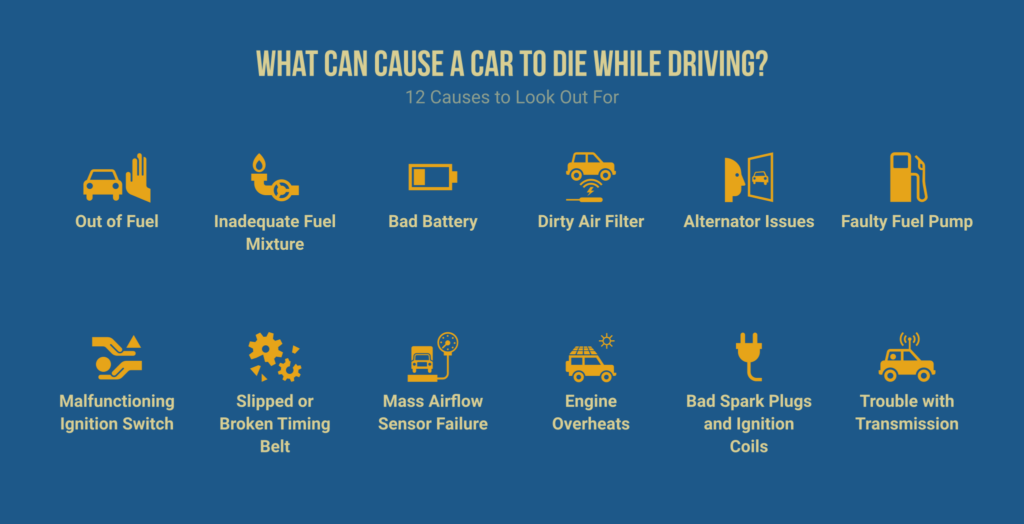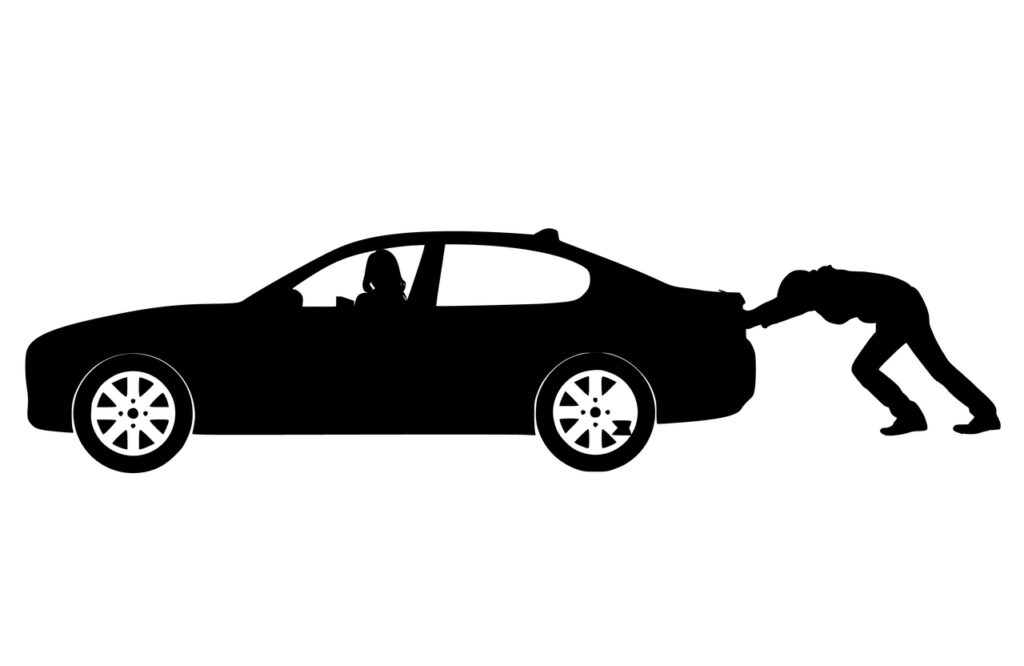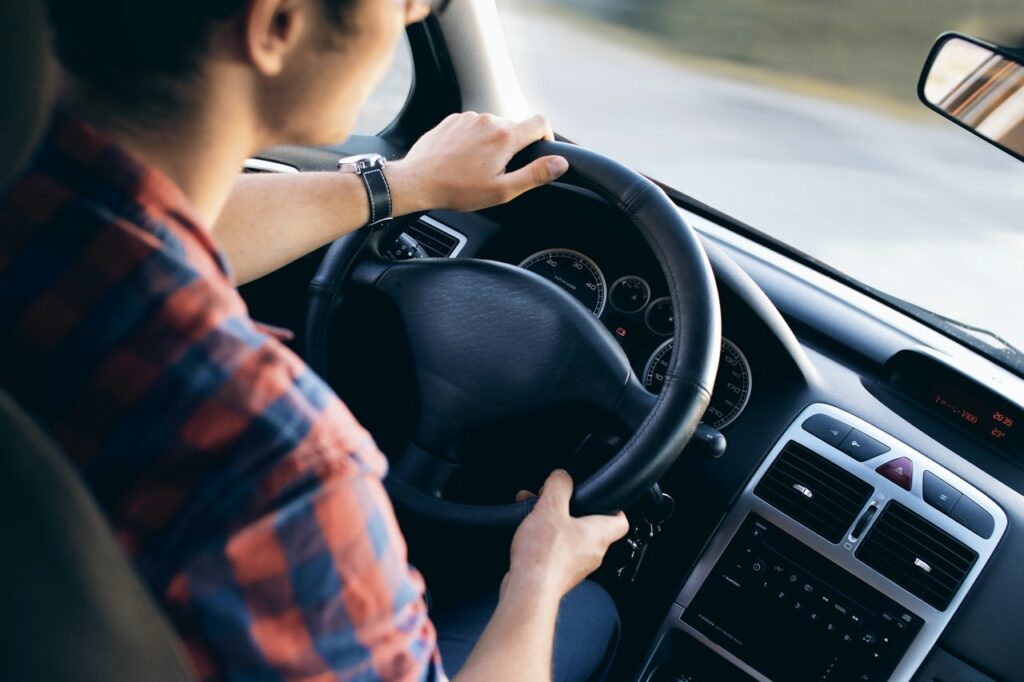What can cause a car to die while driving? It can be a frightening experience, and it can happen to anyone. The worst-case scenario has your vehicle break down on the road or an overcrowded street. What causes this to happen? What are your options if your car dies when you’re driving? There are many potential causes, some of which are more serious than others.
This blog post will discuss the potential causes of a car dying while driving. By being aware of these causes, you can take steps to prevent them from happening in the first place!
Car to Die While Driving: Causes, Fixes, and Solutions

Cars are one of the essential pieces of technology in our lives. We rely on them to get us where we need to go, but what happens when they die on us while we’re driving? Here are some of the most common causes of a car to die while driving:
❕Out of Fuel
Running out of fuel is one of the most common causes of a car to die while driving. If you’re driving and your car starts to sputter, it’s likely because you’re low on gas. You’ll probably notice the low fuel light come on before the car dies, but if you’re driving in an unfamiliar area or on a long trip, it’s easy to misjudge how much fuel you have left.
▸Solution:
To avoid this situation, always keep an eye on your gas gauge and refuel before getting too low. It’s also a good idea to keep a spare gallon of gas in your trunk, just if you run out.
❕Inadequate Fuel Mixture
Your fuel mixture may be insufficient if your car stalls whenever it’s cold or stalls often. It can happen if the air/fuel mixture isn’t rich adequately. It is a common problem in carbureted engines.
▸Fix:
Check the carburetor to see if it’s dirty or needs adjustment. You may be able to clean it yourself, or you may need to take it to a mechanic.
❕Bad Battery
It is a rather typical problem. If the car battery dies when you’re driving, it won’t be able to provide power to a variety of crucial components, causing your vehicle to stall. The ignition engine, for instance, needs to initiate the complete combustion in the engine. Since the battery powers the ignition engine, the ignition system would also stop working whenever the battery dies.
▸Solution:
A dead battery requires no more than 15 minutes to replace, or even premium batteries would cost $200 or more. The majority of batteries would last two to five years. However, it may run flat sooner. So, it is best to keep an eye on its performance. If the battery gets old, have it tested and replaced before it fails.
❕Dirty Air Filter
A dirty air filter will prevent enough air from getting into the engine, leading to a loss of power and eventually causing a car to die while driving. The air filter prevents dirt and debris from getting into the engine, so keeping it clean is essential.
▸Fix:
You can clean or replace your air filter yourself or take it to a mechanic. Replacing the air filter is usually a quick and easy job that doesn’t cost much money.
❕Alternator Issues
The alternator is what charges the battery and powers the electrical system while the engine is running. If it fails, the battery will eventually die, and the car will stall. Since the battery has limited power, it won’t be able to keep the car running for long.
▸Fix:
The alternator is a more complex part and usually needs to be replaced by a mechanic. It’s not a very expensive repair, but it will take some time. You may also save money by doing it yourself, which eliminates the need for you to pay for labor expenses.
On the other hand, alternatives are more difficult to install because the drive belt or serpentine must be attached. The alternator will not operate properly if these are improperly handled, and there isn’t sufficient strain. It is not recommended if you are not a DIY enthusiast, as it needs to follow a specific order and process.
❕Faulty Fuel Pump
If the fuel pump is not working, the engine will eventually die. The fuel pump is what moves gas from the tank to the engine, so if it fails, the engine won’t be able to get the fuel it needs to run. Some fuel pumps could survive up to 15 years, but others can malfunction sooner. Check your car’s fuel pump if it twitches before turning it off.
▸Solution:
The fuel pump is usually a fairly simple repair that can be done by a mechanic or even a DIYer. However, if it is not done correctly, it could lead to more severe problems. To do this, you will need to remove the fuel pump and then install a new one. Make sure to follow all of the instructions carefully not to cause any further damage. If you are unsure of how to fix the fuel pump yourself, It is best to consult with a professional.
❕Malfunctioning Ignition Switch
The ignition switch is what turns the car on and off. If it fails, the car will eventually die. The ignition switch is located on the steering column or dash. It is a rather small switch. The engine may lose power due to vibrations whenever the ignition switch wears out, similar to striking a pothole on the roadway. And this can cause a car to die while driving.
▸Solution:
Other ignition system issues include the ignition coil or ignition control module, ballast resistor, or battery when the car has a distributor and a single coil.
If your vehicle doesn’t start, it might be due to a broken wire or circuit. You can troubleshoot this problem by checking the fuse box for a blown fuse. If you find one, replace it and see if that fixes the problem. If not, you’ll need to take your car to a mechanic or auto electrician to have it checked out.
❕Slipped or Broken Timing Belt
A timing belt keeps the engine’s valves and pistons in sync. If it breaks, the engine will stop running and won’t be able to start again. The timing belt is located inside the engine and is usually made of rubber. It can last for many years, but it will eventually need to be replaced.
▸Fix:
You will need to take your car to a mechanic to replace the timing belt. It is a fairly simple repair, but it can be expensive if the broken belt damages the engine.
❕Mass Airflow Sensor Failure
The mass airflow sensor tells the engine how much air is entering it. If it fails, the engine will eventually die. The mass airflow sensor is located in the air intake system and is usually plastic. It can fail for various reasons, including age, contamination, or damage. It may cause the car to turn off in rare cases. Like the fuel pump issue, you’ll notice your vehicle shaking before it dies. A replacement MAF ( Mass Air Flow ) will cost you roughly $450.
▸Fix:
You will need to take your car to a mechanic or auto electrician to have the mass airflow sensor replaced. It is a simple repair that can be done in a few hours.
❕Engine Overheats
Another typical cause of a car’s death while driving is engine overheating. Overheating may occur for a variety of causes. However, the major reason is an issue with coolant pumping from around the engine or a shortage of engine coolant. When your engine overheats, it will first cause the car to lose power and then eventually die.
A low coolant system pressure, a damaged timing belt, or a burst water pump may cause a lack of coolant flow. Engine steam from the engine bay, coolant leakage, and overheating are signs of a faulty water pump.
▸Fix:
The best way to avoid engine overheating is to keep up with car maintenance and get it checked as soon as possible when you notice any issues. If your car does overheat, you will need to take it to a mechanic or auto electrician to have the issue repaired. Depending on the cause, the repair could be simple or complex.
❕Bad Spark Plugs and Ignition Coils
See how the battery powers the spark plugs and ignition coils? On the other hand, these components may wear out over time, leading a car to die while driving. It isn’t particularly common since vehicles with faulty ignition systems have a hard time starting in the first place. If the car is malfunctioning and subsequently dies, you may have an issue with the ignition system. Ignition coils and spark plugs are the most prevalent causes.
▸Fix:
If you notice your car is having trouble starting or if the engine is misfiring, it may be time to replace the spark plugs and ignition coils. It is a simple repair that can be done at home with a few tools. However, if you are not comfortable doing it yourself, you can take it to a mechanic or auto electrician.
Spark plugs must be replaced every 20,000–30,000 miles, and it will cost less than $10. Ignition coils must last 100,000 miles and cost much more than $450, plus labor.
❕Trouble with Transmission
A car that dies while driving may also have transmission problems. The most common transmission problem is a clutch release issue. Clutch release problems occur when the pressure plate fails to release the clutch, causing the engine to stall. It can happen due to various reasons, including age, contamination, or damage.
▸Fix:
If you think you may have a clutch release problem, it is best to take your car to a mechanic or auto electrician for diagnosis and repair. It is a complex repair that should only be done by a professional.
These are just a few of the many potential causes of a car dying while driving. If you are having trouble with your car, it is best to take it to a mechanic or auto electrician for diagnosis and repair.
Most repairs can be done relatively easily and inexpensively. However, some repairs may be complex and expensive. Either way, it is always best to find out what is wrong with your car as soon as possible to avoid further damage.
What to Do if a Car Dies While Driving

The safety of yourself and other passengers must be your primary concern. If your car dies while you’re driving it, follow these steps:
I. Stay calm and guide the car out of the road
If you can do so without causing an accident, try to guide the car off to the side of the road. Do your best to stay calm and avoid panicking. If slowing it down is too tough, go to a safe spot and utilize the emergency brake. If you can’t restart the vehicle straight away, try to park out from the road as much as you can.
II. Turn on your hazard lights
Turn on your hazard lights as soon as it’s safe to do so. It will warn other drivers that there’s an issue, and they should be cautious when approaching your vehicle. If you have flares or reflective triangles, set them up behind your car to make them more visible.
III. Try restarting the car
If it’s safe to do so, try restarting the car. If the engine doesn’t turn over, there may be an issue with the battery, starter, or fuel system. Wait a few minutes and try again. If the car still doesn’t start, move on to the next step.
IV. Call for help
If you can’t restart the car, you’ll need to call for help. If you have a roadside assistance plan, now is the time to use it. If not, you can call a tow truck or the police.
It is vital to remain calm and take the proper steps if your car dies while driving. By following these steps, you can help ensure your safety and the safety of others.
How to Prevent a Car to Die While Driving

Among the common causes of a car to die while driving can be easily prevented with some basic maintenance, including:
✔️Checking Battery Regularly
One of the most common reasons a car won’t start is because of a dead battery. Batteries typically last about three to five years, but extreme temperatures and other factors can shorten their lifespan. To extend the life of your battery, be sure to check it regularly and clean the terminals as needed.
It’s also a good idea to have your battery tested by a professional every few years to ensure it’s in good condition.
✔️Air Filter Maintenance Is Necessary
A dirty air filter can cause several problems, including engine stalls. To prevent this, be sure to check your air filter regularly and replace it as needed.
Typically, a dirty air filter will not turn your car off completely. In the worst-case scenario, it will “just” make the car jolt or malfunction while driving. However, failing to replace or clean a filthy air filter might reduce the life of the MAF sensor.
Change the air filter as necessary, normally every 10,000 miles. It should only cost you $20 to replace them.
✔️Keep Your Car Clean
One of the best ways to keep your car running properly is simply keeping it clean. Over time, dirt and grime can build up on essential parts, causing them to malfunction. To avoid this, be sure to wash both the inside and outside of your car regularly. In addition, have your car detailed every few months to ensure that all parts are clean and in good condition.
A car that is kept clean both inside and out will last longer and run more efficiently than one that is neglected.
✔️Checking and Changing Oil Regularly
Another important maintenance task is to check and change your oil regularly. Depending on your car type, you’ll need to change your oil every five to seven thousand miles.
Not changing your oil regularly can lead to several problems, including engine damage. To avoid this, be sure to keep up with your oil changes. You can do this yourself or take your car to a professional.
✔️Keeping Gas Tank at Least Half Full
If you let your gas tank run too low, you run the risk of damaging the fuel pump. To avoid this, be sure to keep your gas tank at least half full. In addition, be sure to use the type of gasoline recommended by your car’s manufacturer. Using lower-grade gasoline can damage your engine and reduce your car’s performance.
✔️Check Alternator for Any Signs of Damage
The alternator is what charges your car’s battery. If the alternator is damaged, your battery will not be able to hold a charge. To avoid this, be sure to have your alternator checked regularly for any signs of damage. You can do this yourself or take your car to a professional.
The Consequences of a Car Dying While Driving
It Can Be Extremely Dangerous
If your car dies while driving, it can be extremely dangerous. For example, if you’re on a busy highway, you could cause a serious accident. In addition, if your car stalls in the middle of the road, you could be hit by another car.
Inconvenient and Costly
Even if you’re not in a dangerous situation, a car that dies while you’re driving can be extremely inconvenient. If your car dies while you’re on your way to work or running errands, you could be late or have to cancel your plans. In addition, if your car needs to be towed or repaired, it can be costly.
It Can Make You Stranded
If your car dies while you’re driving, you could be stranded. If you’re in a remote location or far from home, you might have to call a tow truck or wait for help. In addition, if your car needs to be repaired, you might have to stay at a hotel or rental car company until it’s fixed.
Frequently Asked Questions
Q: Can a dirty air filter cause my car to die while driving?
Most people don’t realize that a dirty air filter can cause serious problems for their car. A dirty air filter restricts airflow to the engine, which can cause many problems. For one thing, it can cause the engine to overheat. It can also cause spark plugs to misfire, putting extra strain on the entire electrical system. Worst of all, it can cause the engine to stall while you’re driving! So if you’ve been having trouble with your car stalling, it might be time to check your air filter.
Q: Can natural catastrophes cause my car to break down?
Yes. A natural disaster can cause your car to break down in some ways. For example, a flood can short out the electrical system, a hurricane can blow away or damage the roof, and an earthquake can knock over power lines or damage the car’s structure.
If you’re evacuating due to a natural disaster and your car break down, don’t panic! Just stay calm and use your emergency supplies to fix the problem. If you have a spare tire, put it on; if you have a jack and lug wrench, use them to change the tire; if you have jumper cables, use them to start the engine. If you’re stuck in your car overnight, stay warm by using blankets or sleeping bags and keep the engine running (if possible) to stay warm. Remember, the most important thing is to stay safe!
Q: Is it possible for a bad battery to cause a car to die while driving?
A car battery is critical to the proper functioning of a vehicle. It provides the electrical current that powers the starter motor and ignites the fuel in the engine. Without a properly working battery, a car won’t start. Additionally, a weak or dead battery can cause problems while driving, from dimming headlights to stalling engines. In some cases, a bad battery can even cause a car to die while driving.
There are several reasons why a battery might fail prematurely. One possibility is that it wasn’t properly maintained and didn’t receive regular cleanings and inspections. Another possibility is that it was exposed to extreme temperatures, which can damage the battery’s internal components. Sometimes, batteries simply fail due to manufacturing defects.
Q: My car shut off while driving and won’t start. What could be wrong?
There could be a few different things wrong if your car shuts off while driving and won’t start again. It could be an issue with the electrical system, perhaps a loose wire or a faulty connection. Or, it could be a problem with the fuel system – maybe you’re out of gas, or something is blocking the flow of gas to the engine. If your car has a manual transmission, it’s also possible that you simply blew a fuse when shifting gears.
In any case, it’s best to take your car to a mechanic and have them diagnose the problem. They’ll be able to narrow down the list of potential issues and recommend the best course of action for getting your car up and running again.
Q: What if my car starts to overheat while I’m driving?
If your car starts to overheat, the first thing you should do is pull over and turn off the engine. Once the engine is cool, check the radiator for leaks. If there are no leaks, add water or coolant to the radiator and try starting the engine again.
Next, downshift to a lower gear if you have an automatic transmission. It will help the engine to run cooler. Then, turn on the heater full blast. It will help to draw heat away from the engine. Third, pull over and turn off the engine as soon as it is safe. Once the engine is cool, check the radiator for leaks. If there are no leaks, add water or coolant to the radiator and try starting the engine again.
If your car overheats and can’t fix the problem, call a tow truck and have your car towed to the nearest service station. Do not attempt to drive your vehicle if it is overheating – this could cause severe damage to the engine.
Final Thoughts
There are a number of different things that can cause a car to die while driving. We have outlined some of the most common causes in this article, but this is by no means an exhaustive list. If your car dies while driving, the best thing to do is stay calm and assess the situation. If you can, safely pull over to the side of the road and call for help. In any case, it’s best to err on the side of caution and have it checked out by a professional.

